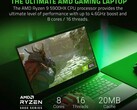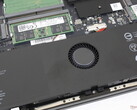We all know the common benefits of OLED over IPS. Significantly faster black-white and gray-gray response times, much deeper black levels, frequently wider color coverage, and a more uniform brightness distribution from corner to corner all contribute to noticeably higher image quality. The key attribute that OLED has yet to crack over IPS has been refresh rate — until now.
Razer's recent announcement of a 15.6-inch 240 Hz OLED panel is notable as all OLED laptop panels thus far have been limited to 60 Hz. It doesn't matter how much better image quality can get when performance is essentially limited to 60 FPS. Though not an issue for typical word processing, picture editing, or video streaming, gamers may still prefer IPS and their faster 300+ Hz refresh rates even if image quality is inferior. There's a reason why almost all gaming laptops continue to offer IPS options with faster and faster refresh rates despite the superior image quality of OLED.
The upcoming 15.6-inch 240 Hz OLED panel should finally close out the single largest advantage that IPS has enjoyed over several years. Should the price difference between 240 Hz OLED and 240 Hz IPS ever reach zero, then there would be almost no reason to chose IPS.
A few OLED panels have started appearing with a 90 Hz refresh rate instead of the usual 60 Hz, but these are still limited to smaller screen sizes at the moment that would be generally unfit for most gaming laptops.
Nonetheless, we still have a concern about OLED regarding pulse-width modulation. Most OLED panels, including the existing 60 Hz one that's already available on the Blade series, exhibit some flickering at most brightness levels. A small subset of users may notice the flickering or perceive onscreen motion to not be as smooth when compared to IPS regardless of the high refresh rate of OLED. It'll be interesting to see how or if the 240 Hz OLED panel will address this potential problem. Once the panel becomes available on the Razer Blade 15, we fully expect it to begin appearing on other high-end 15.6-inch gaming laptops down the line as well.


 Deutsch
Deutsch English
English Español
Español Français
Français Italiano
Italiano Nederlands
Nederlands Polski
Polski Português
Português Русский
Русский Türkçe
Türkçe Svenska
Svenska Chinese
Chinese Magyar
Magyar















